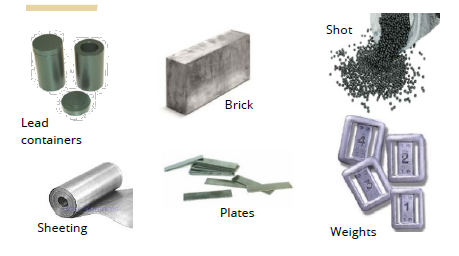- Hits: 2364
The work with lead
METTALIC LEAD SAFETY
LEAD HAZARDS
Lead is a toxic metal that can cause many acute and chronic health effects. Lead can affect the nervous stored in tissue and bones for many years and may reach toxic levels later in life.
Inhalation of lead dust or fumes from improper handling of lead, abrasion, soldering or welding.
Ingestion of lead from contaminated hands or surfaces.
TYPES OF METALLIC LEAD

HOW IS METALLIC LEAD USED AT THE UW?
Radiation shielding
Research
Medical applications
Scuba diving.
PREVENT LEAD EXPOSURE
The best method of preventing lead exposure is to eliminate its use by using an alternative lead-free material, or changing a process so that lead is not needed. If not possible, controls must be put in place to minimize potential exposures.
Always work with lead materials in a well ventilated area. Use local exhaust if needed.
Register the lead in the MyChem inventory and submit a safety data sheet (SDS).
Develop a standard operating procedure (SOP) and/or conduct a job hazard analysis (JHA) for the lead work to ensure safe handling, use, storage and
disposal as hazardous waste.
Train employees on lead hazards, SDSs, SOPs and JHAs.
Ensure chemicals and lead products are labeled and
storage areas have signs indicating hazards.
Wear personal protective equipment (PPE), including safety glasses/goggles and disposable gloves when handling lead. Wear clothing that covers arms and legs or a lab coat, and closed toe shoes.
To avoid injury, use a mechanical lifting device when working with 25 pounds or more of lead bricks, sheets or weights.
Manage housekeeping and cleaning in work areas to avoid contaminating surfaces and other areas.
Conduct surface testing for lead contamination as needed.
Always wash hands after working with lead materials, before leaving the work area, and before eating or drinking.
PREVENT “TAKE-HOME” LEAD
Clean work surfaces with damp wipes. Do not contaminate clothes, shoes, and skin that can carry lead into your car and home, and accidentally expose family members.
Children are especially susceptible.
CONTROL LEAD OXIDATION
When raw lead is exposed to air and moisture, films of lead oxides, lead carbonates, and lead sulfate can form on the surface as a powdery coating. These may be white, yellow, or other colors on unprotected lead bricks, weights, or other lead materials. These lead salts can contaminate the work or storage area and become airborne if disturbed, and potentially be inhaled.
The oxidation of lead is reason to emphasize the importance of always wearing gloves when handling metallic lead and monitoring its condition.
Lead materials can be encapsulated or covered as shown below to minimize oxidation and lead exposure potential.

Storing lead materials in plastic containers or plastic bags in dry areas can also reduce the occurrence of oxidation and other reactions.
Lead can be purchased in covered or encapsulated form.
HOT WORK: SOLDERING, WELDING
Wear appropriate PPE, including safety glasses/goggles, disposable gloves, and full-body covering, (face shield, respirator as needed).
Always work in well ventilated area or use local exhaust ventilation.
Upon completion of lead work, all waste and PPE must be disposed of properly, and respirators, if used, must be properly cleaned.
CLEANING METHODS
Use wet cloths to clean surfaces, capture debris and to contain dust.
For larger areas, vacuum with a HEPA vacuum cleaner designated specifically for lead cleanup, to capture lead dust at the source or to clean contaminated surfaces.
Perform vacuum maintenance with appropriate PPE and use procedures that contain airborne lead dust.
Do not dry-sweep lead dust. Use a wet mop or a HEPA vacuum.
WASTE MANAGEMENT
Lead waste must be treated as hazardous waste and disposed of according to local hazardous waste regulations.
Discard lead waste in a labeled waste container.
Never put contaminated items into regular trash.
For collection, recycling, and disposal information, contact EH&S Environmental Programs at 206.616.5835 or This email address is being protected from spambots. You need JavaScript enabled to view it..
RESOURCE
UW Lead Safety Program Manual
